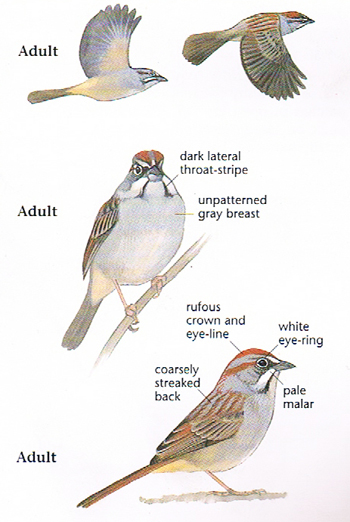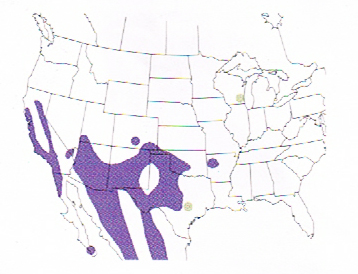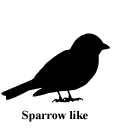|
Cool Facts |
 Photo
taken from:
The
Sibley Field Guide to Birds of Western North America by
David Allen Sibley
Photo
taken from:
The
Sibley Field Guide to Birds of Western North America by
David Allen Sibley
|
- The Rufous-crowned
Sparrow was described in 1852 by John Cassin as
Ammodramus ruficeps. It is also known as the Rock
Sparrow because of its preference to live on rocky
slopes.
- The derivation of
the current genus name, Aimophila, is from aimos,
'thicket' and phila, 'loving'. Its species name is a
literal derivation of its common name, derived from the
Latin words rufus 'rufous' and -ceps, from caput 'head'.
- Male sparrows
maintain and defend their territories throughout the
year.
- A group of sparrows
has many collective nouns, including a "crew",
"flutter", "meinie", "quarrel", and "ubiquity" of
sparrows.
|
|
Description |
- Size: 13-14 cm (5-6 in)
- Wingspan: 21 cm (8 in)
- Weight: 13-17 g (0.46-0.6 ounces)
- Small sparrow.
- Gray head with solid rufous crown.
- Rufous stripe behind eye.
- one black mustache stripes on each side of bill.
- Streaked upperparts.
- Plain gray underparts.
- Long, rounded tail.
- Crown with thin light stripe down middle.
- Gray bill, pinkish.
- Eyes brown.
- Legs brownish.
|
Sex
Differences
Sexes look alike.
Immature
Juvenile lacks strong
rufous of adult, and is streaked on chest.
|
|
Range Map |
|
Taxonomic Hierarchy |

|
|
Kingdom: |
Animalia |
|
Phylum: |
Chordata |
|
Subphylum: |
Vertebrata |
|
Class: |
Aves |
|
Order: |
Passeriformes |
|
Family: |
Emberizidae |
|
Genus: |
Aimophila |
|
Species: |
Aimophila ruficeps |
|
Subspecies: |
-
Aimophila ruficeps
australis
-
Aimophila ruficeps boucardi
-
Aimophila ruficeps
canescens
-
Aimophila ruficeps duponti
-
Aimophila ruficeps eremoeca
-
Aimophila ruficeps extima
-
Aimophila ruficeps fusca
-
Aimophila ruficeps
laybournae
-
Aimophila ruficeps obscura
-
Aimophila ruficeps
pallidissima
-
Aimophila ruficeps
phillipsi
-
Aimophila ruficeps ruficeps
-
Aimophila ruficeps rupicola
-
Aimophila ruficeps
sanctorum
-
Aimophila ruficeps scottii
-
Aimophila ruficeps simulans
-
Aimophila ruficeps sororia
-
Aimophila ruficeps suttoni
|
|
|
Sound |
|
Song is a series of short clear notes or longer whistles,
followed by a trill. Calls include a very high "tzeet" and
short pips.
|
|
Identification and
Information
See
Anatomy
of a Bird
|
|
Body |
- Length
Range: 15 cm (6 in)
- Weight:
20 g (0.7 oz)
- Size:
2. Small (5 - 9 in)
- Color
Primary: Gray
- Underparts:
Gray
- Upperparts:
Gray-brown with red-brown streaking.
- Back
Pattern: Striped or streaked, Mottled
- Belly
Pattern: Solid
- Breast
Pattern: Solid
|
|
|
|
Head |
- Bill Shape:
Cone
- Eye Color:
Brown or tan.
- Head
Pattern: Eyeline, Capped, Striped,
Eyering, Malar or malar stripe
- Crown Color:
Red-brown
- Forehead
Color: Red-brown
- Nape Color:
Red-brown
- Throat
Color: White
- Cere color:
No Data
|
|
|
Flight |
- Flight
Pattern: Short flights., Alternates
several rapid wing beats with wings pulled to
sides.
- Wingspan
Range: 23 cm (9 in)
- Wing Shape:
Pointed-Wings
- Tail Shape:
Rounded Tail
- Tail
Pattern: Solid
- Upper Tail:
Dark Brown
- Under Tail:
Dark Brown
- Leg Color:
Pink-gray
|
|
|
Breeding |
-
Breeding Location:
Grasslands, Forests
-
Breeding Type:
Monogamous, Solitary nester
-
Breeding Population:
Common locally
- Egg
Color:
White to pale blue
- Number
of Eggs:
2 - 5
-
Incubation Days:
11 - 13
- Egg
Incubator:
Female
- Nest
Material:
Bark, sticks, weeds, and grass., Lined with
mammal hair.
-
Migration:
Nonmigratory
- Condition at Hatching: Helpless
with sparse dark down.
|
|
|
Other
Names |
Similar
Species |
|
|
- Rufous-winged Sparrow is smaller, dusky upper bill,
pinkish lower mandible, and two thin black mustache stripes on each side
of bill.
|
|
Conservation Status |
|
Habitat loss from grazing and development has led to
declines and elimination of local
Rufous-crowned Sparrow populations. |
|
Habitat |
Sources
used to Construct this Page: |
|
Inhabits open oak woodlands and dry uplands with grassy vegetation
and bushes, often near rocky outcrops. |
- P. E. Lowther, K. D. Groschupf, and S. M. Russell.
1999. Rufous-winged Sparrow (Aimophila carpalis).
In The Birds of North America, No. 422 (A. Poole
and F. Gill, eds.). The Birds of North America, Inc.,
Philadelphia, PA.
|
|
Food |
|
Seeds and arthropods. |
|
Behavior |
|
Pecks at ground and at bases of grass stems. |
|
|
|
|

